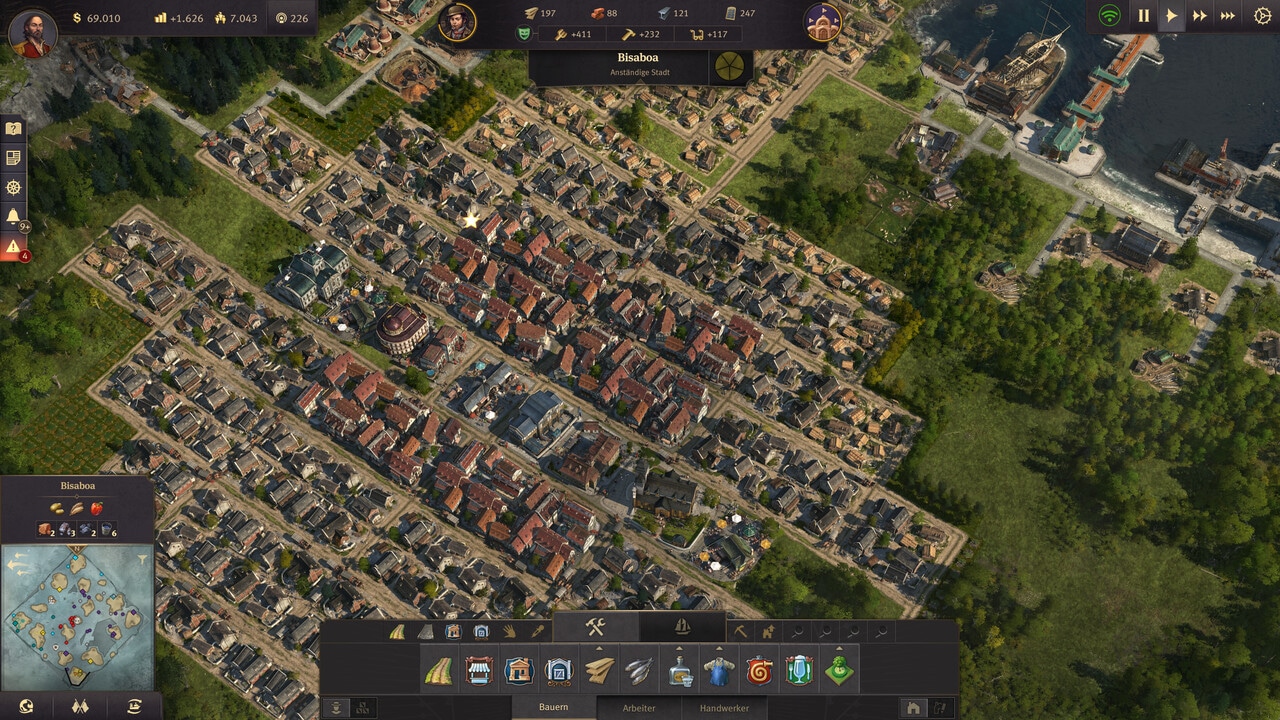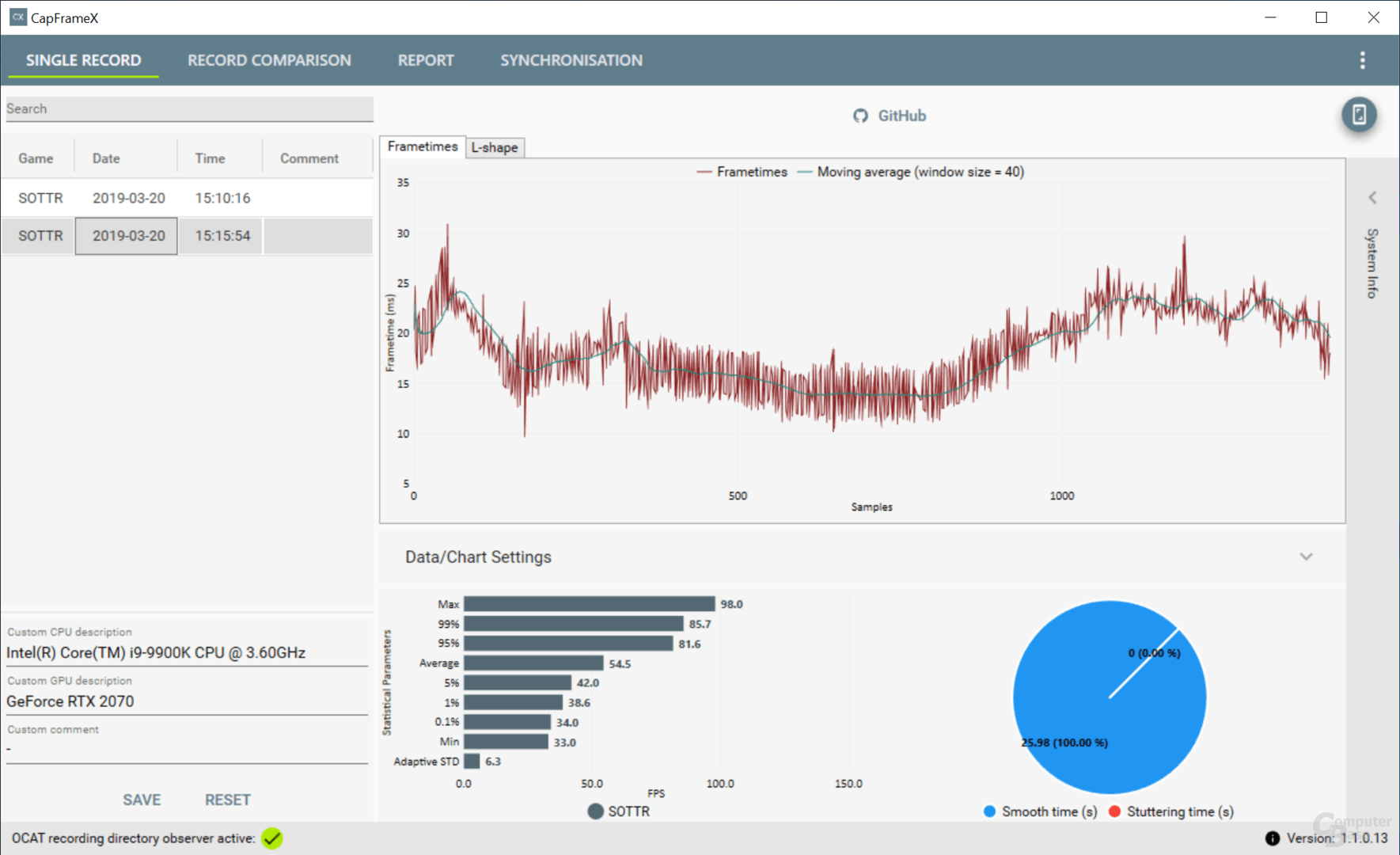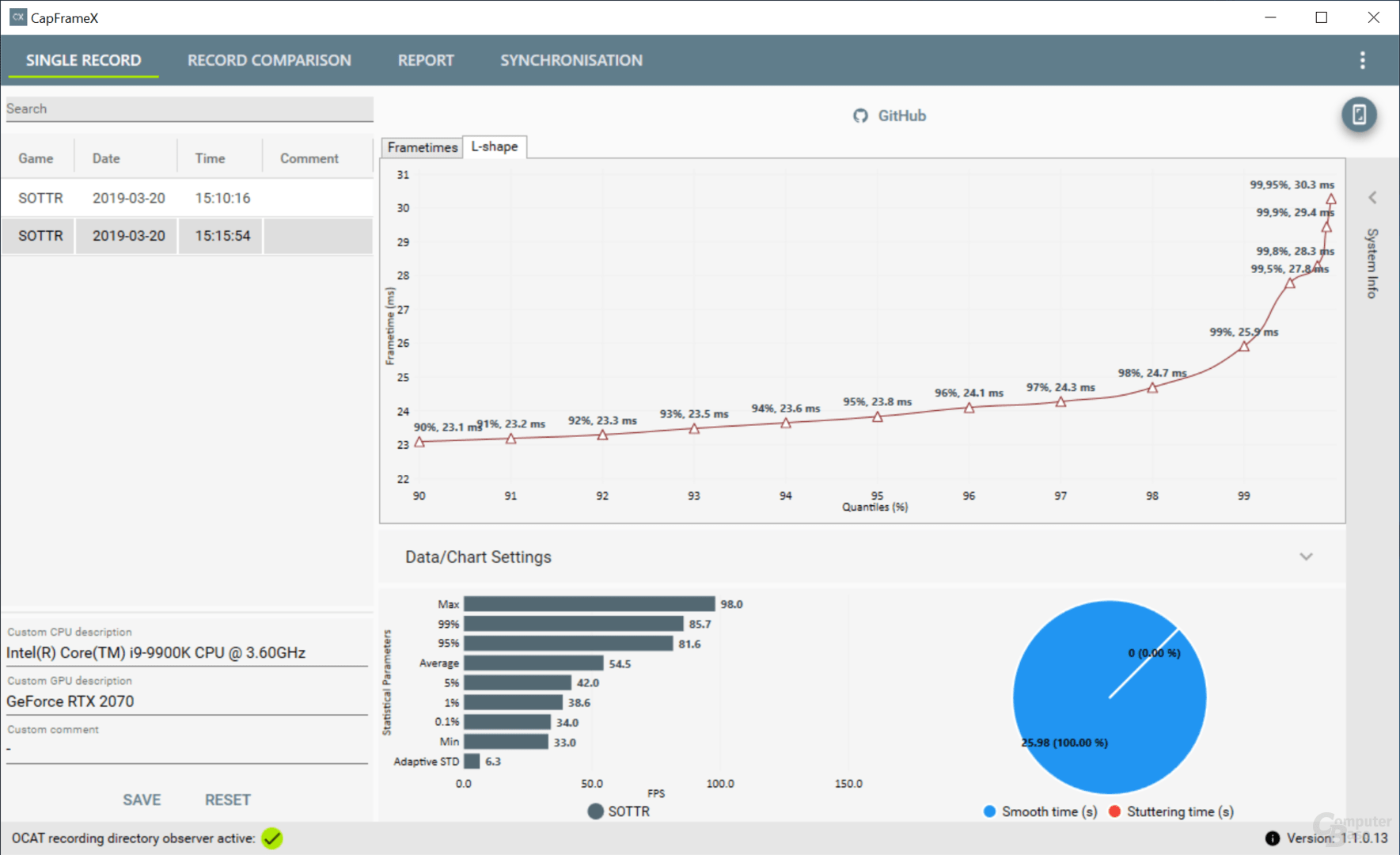– Anno 1800, which many players have been craving since the announcement, has been available this week. In a first technology test, the editorial team showed just in time for the start how fast the title runs with which settings on which PC. But there is much more that can be done with the community. Here is the guide.
Update 04/26/2019 12:30 p.m.
Update 04/24/2019 10:03 a.m.
Busy reader benchmarks
BitcoinMinersHashrate published a technology test for Anno 1800 on Monday and since then has made a whole series of additions – also at the request of the community. Nonetheless, the system configurations and game settings used in the article still represent only a fraction of what BitcoinMinersHashrate readers use at home. However, the community's need for benchmarks for more configurations and settings can only satisfy one person: the community itself.
After the community test on Metro Exodus, Cinebench R20 and Apex Legends, BitcoinMinersHashrate is again calling for collective testing over the Easter weekend (and beyond). Those who want to participate can find all the information they need below.
That is savegame and test sequence
For starters, the community test relies on the test sequence from the editorial team's technology test. We offer the benchmark savegame for download (use the current packing program). To use it, Anno 1800 must have been started at least once and a new game started.
Then there is in Windows Explorer Documents the folder Anno 1800, The savegame must be stored there in the directory shown below.
This should be noted in the test sequence
If the game status "BitcoinMinersHashrate_10000" (for 10,000 inhabitants) is loaded into the game, please note: The measurement is not started immediately, because the game loads textures, objects (e.g. trees) and residents successively. The OCAT measurement (in this case 10 seconds) is only started when the merchant ship arrives in the harbor and the corresponding message appears in the top left of the game. The video shows the exact time.
These are the settings
Before proceeding to the in-game settings, participants should install the latest drivers. The GeForce 425.31 and the adrenaline 19.4.2 have been officially optimized for Anno 1800.
In the following it is necessary to make the graphics settings required for the respective test in the game. Particular attention must be paid to the following peculiarities:
- Changing the preset always activates VSync
- VSync must be deactivated in all tests
- The bustle factor is not affected by changing the preset
- All tests are done with DirectX 12
- Changes to the presets require a restart
Benchmark instructions with the BitcoinMinersHashrate settings
Community test participants can test Anno 1800 in three resolutions with the settings used by BitcoinMinersHashrate. This means that in Full HD the ultra-high preset with manually reduced 4 × -MSAA (default: 8 × -MSAA), Wuselfaktor (WF) to “ultra-high”, VSync off and DirectX 12 is used. In WQHD and Ultra HD, you switch to the "Very high" preset, which automatically uses 4 × MSAA. In this case, too, DirectX 12 and VSync must be selected and the wobble factor set to "ultra-high" manually.
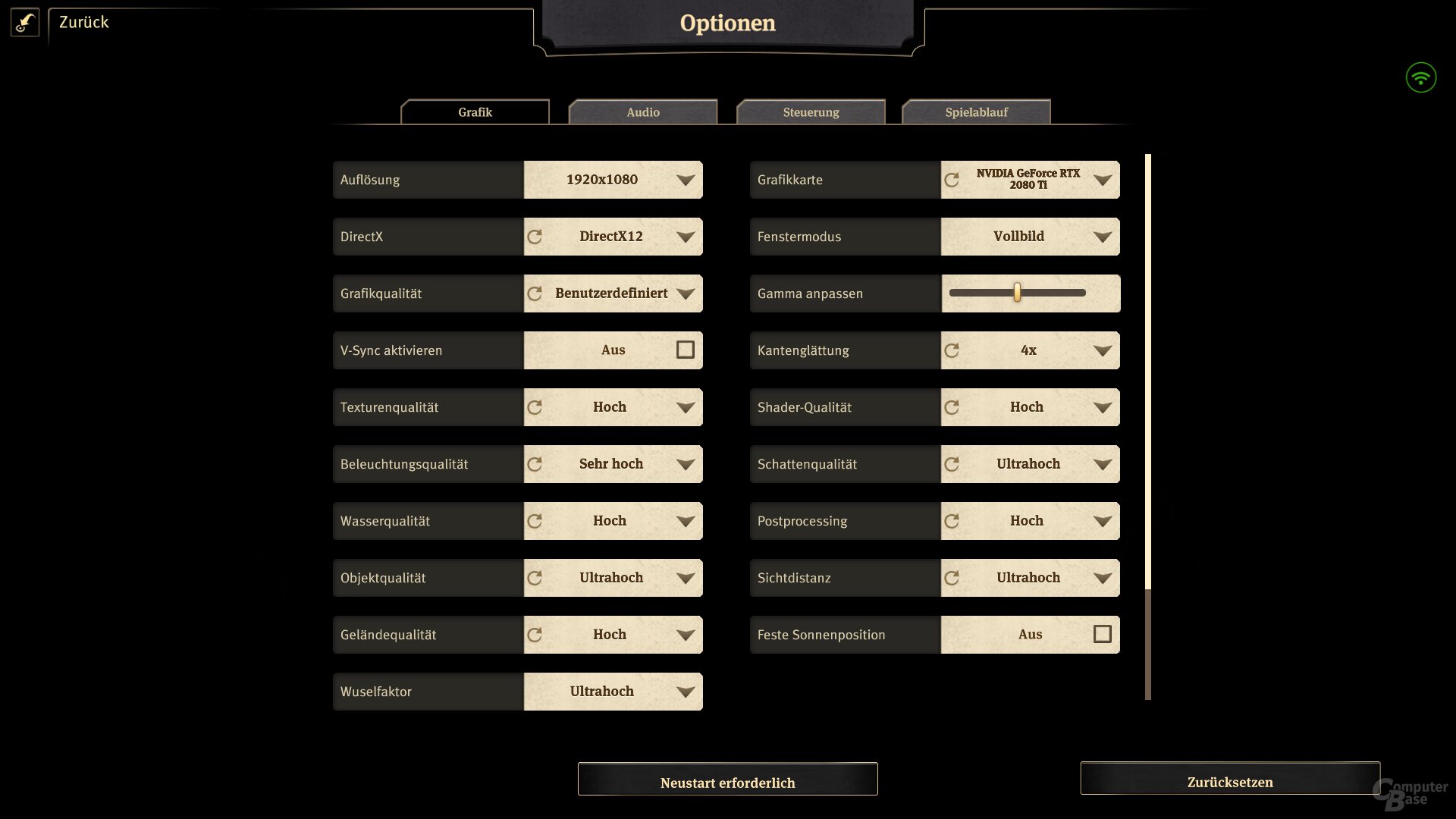
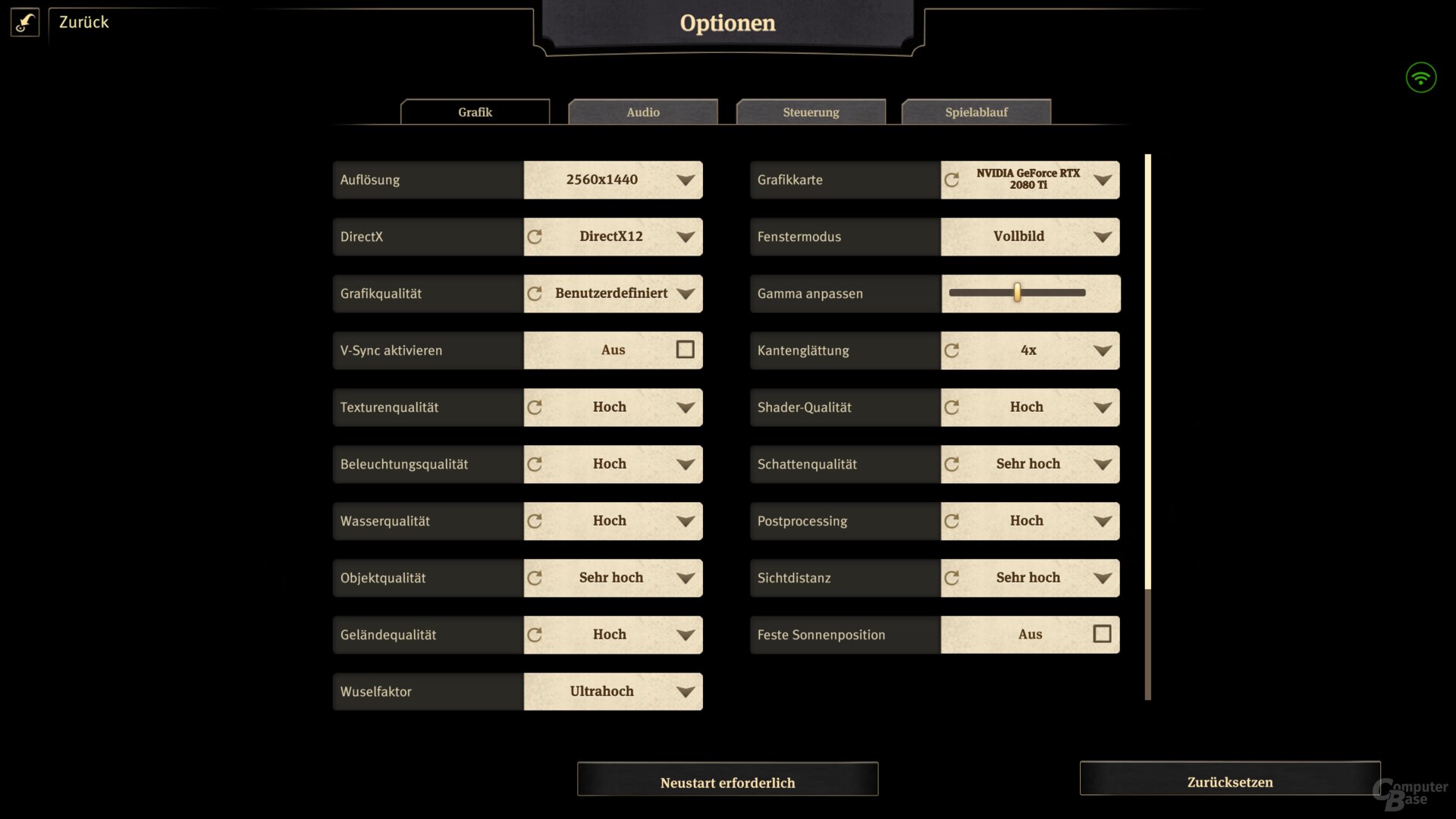
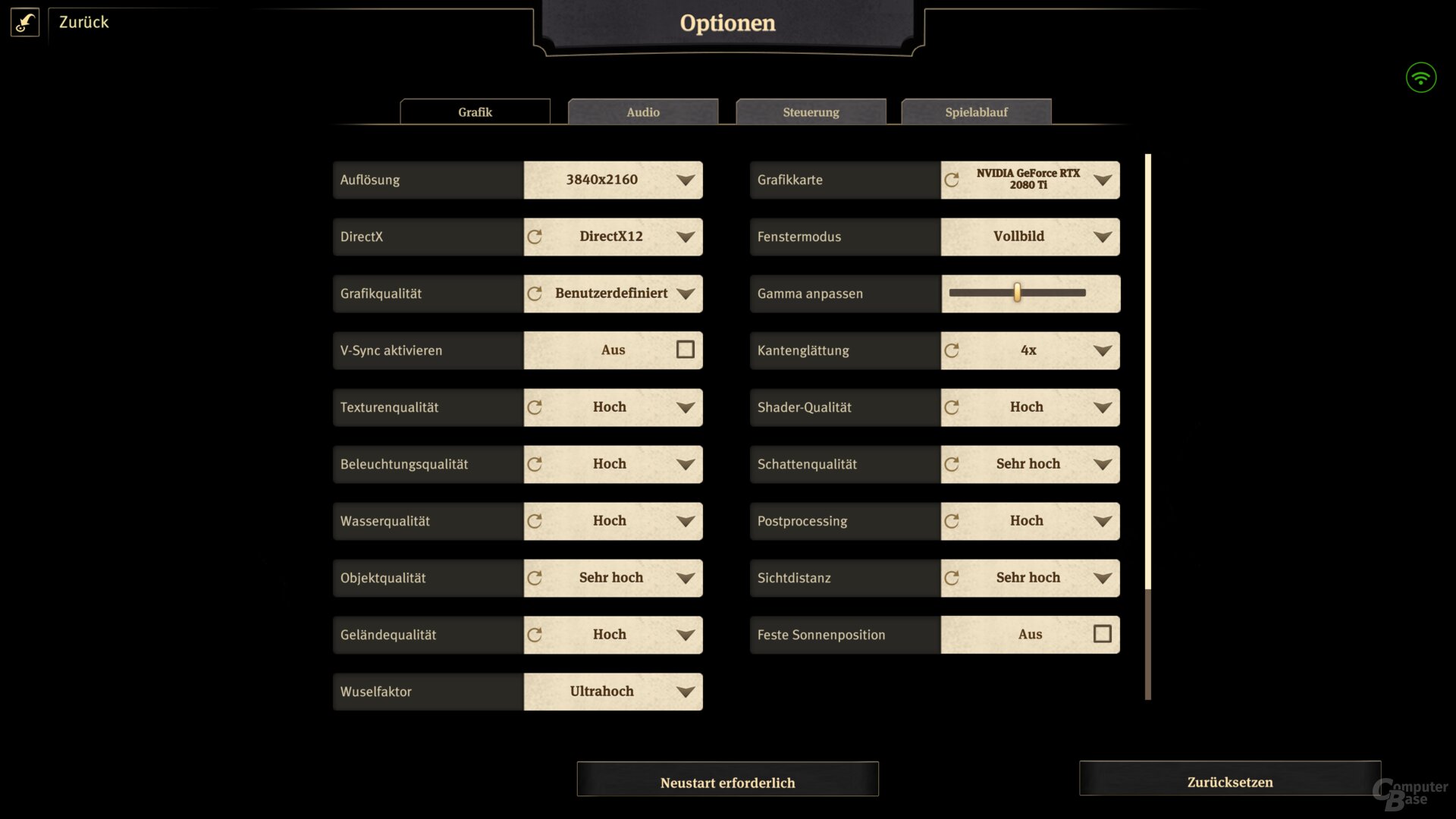
Benchmark instructions with lower requirements
However, the settings used by BitcoinMinersHashrate are extremely demanding. At the request of the readers, less demanding settings are therefore used in the community test. In order to prevent errors, a preset is used in this case that still maintains the graphic style of Anno 1800: Medium. The Wuselfaktor (WF) is also set to "Medium". DirectX 12 and VSync are to be selected.
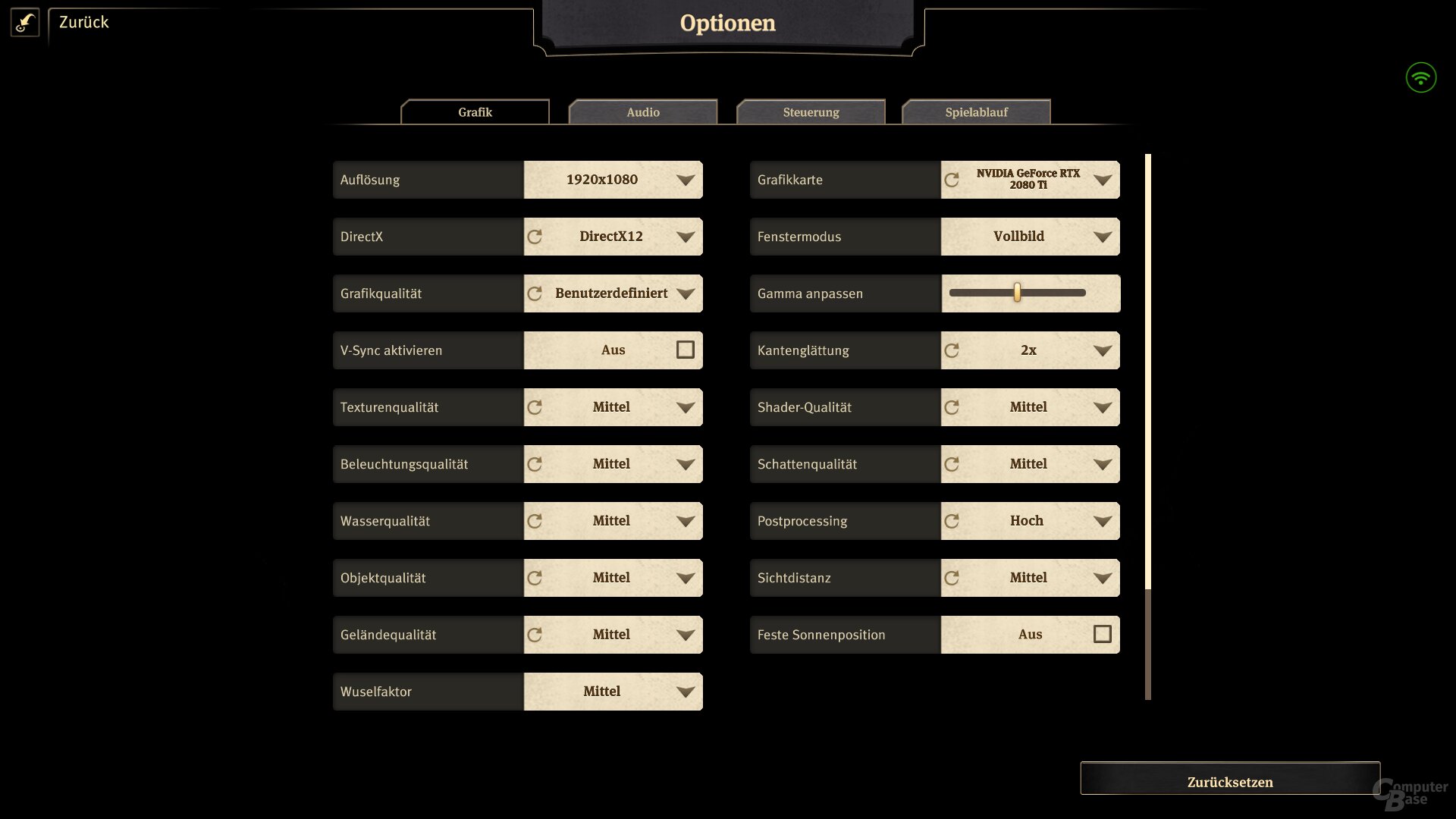
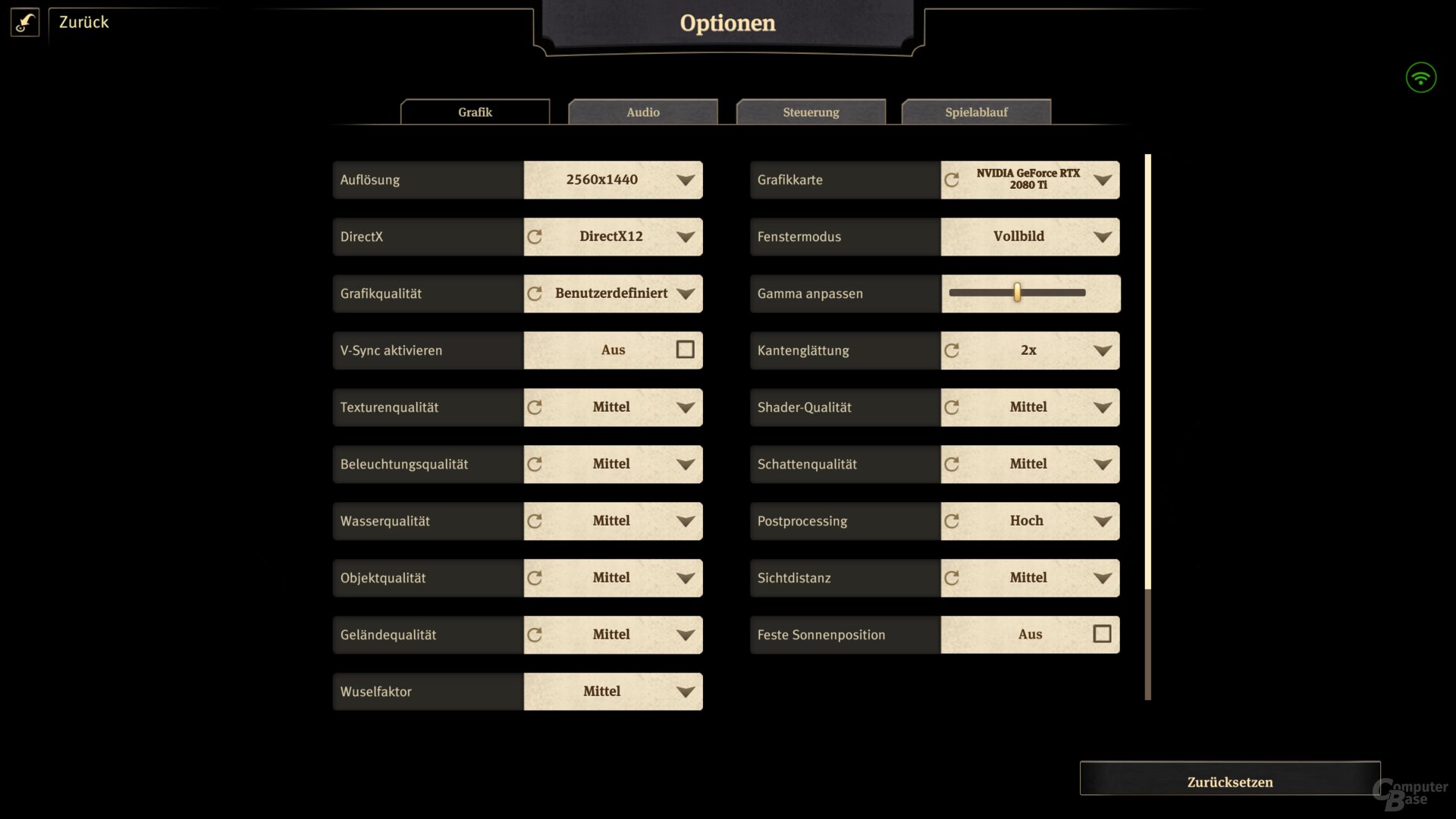
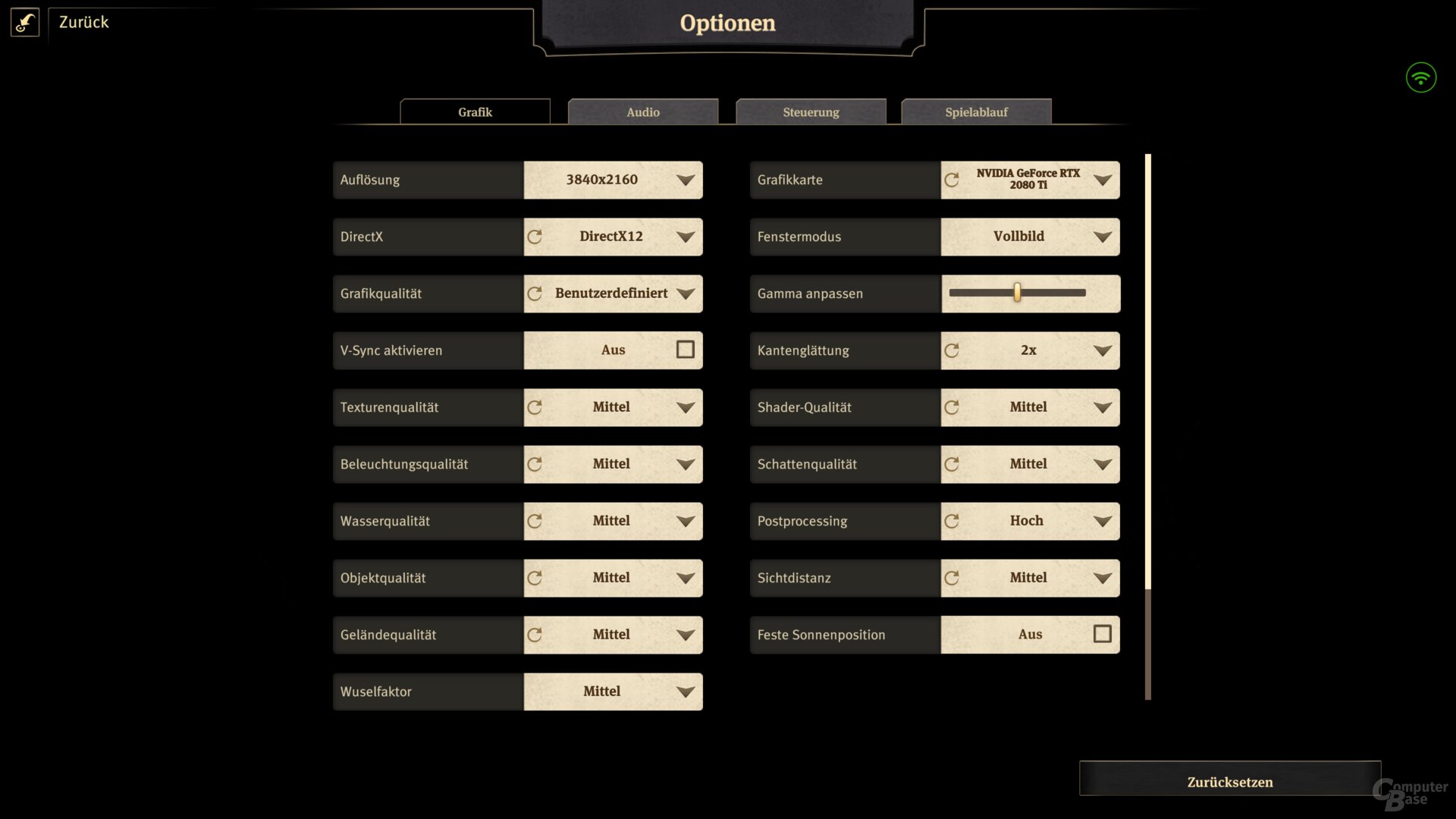
Benchmarks with resolutions in the format 21: 9 or even 32: 9 are always required by the community. And in games like Anno 1800, the extremely wide displays can also provide a real overview advantage. The settings are the same as in the FHD, WQHD and UHD tests with reduced settings.
This is how results are reported
Results can and must also be submitted in this reader test using the form below. If one of the forms is submitted, the CMS automatically creates a contribution in the comment thread of this article. Participants can add further information here, but outside the pre-formatted area – this is automatically evaluated by our CMS. The values for BitcoinMinersHashrate are only visible when the contribution is saved.
It is important to pay attention to the correct name, which must always contain information about the GPU, CPU and RAM. The information is to be provided as the following list and the benchmarks already available show.
- R7 2700, RTX 2080 FE, 32/2933
- R7 2700, RTX 2080 CD, 32/2933
- R7 2700 OC, RTX 2080 CD OC, 32/2933
- R7 2700 UV, RTX 2080 CD, 32/3200
For GPU and CPU it can be specified whether the chip has been overclocked (OC) and / or undervolted (UV). For GPUs, it must also be specified whether it is a reference design (FE), a custom design (CD) or a mobile chip (MQ or M). The RAM is specified according to the GB / TAKT scheme.
- FE = Founders Edition or reference design
- CD = custom design (partner card)
- OC = Overclocked
- UV = Undervolted
- MQ = Max-Q (mobile GPU from Nvidia)
- M = Mobile GPU (except Max-Q)
The form does not have to be filled in completely, and selected results can also be reported. Further measured values can be added later by sending the form again.
Benchmarks with the BitcoinMinersHashrate settings
The following diagrams contain the results for Full HD, WQHD and Ultra HD (switching through) with the high requirements.
Anno 1800 – 1,920 × 1,080 – CB settings
i9-9900K, RTX 2080 Ti FE, 32/3200
i9-9900K, RTX 2080 FE, 32/3200
i9-9900K, RTX 2070 CD, 32/3200
i9-9900K, GTX 1080 FE, 32/3200
i9-9900K, RTX 2060 FE, 32/3200
i9-9900K, Radeon VII FE, 32/3200
i9-9900K, GTX 1070 FE, 32/3200
i9-9900K, RX Vega 64 FE, 32/3200
i9-9900K, GTX 1660 Ti CD, 32/3200
i9-9900K, Vega 56 FE, 32/3200
i9-9900K, GTX 1060 FE, 32/3200
i9-9900K, R9 Fury FE, 32/3200
i9-9900K, RX 590 CD, 32/3200
i9-9900K, GTX 970 FE, 32/3200
i9-9900K, RX 580 CD, 32/3200
i9-9900K, R9 390 CD, 32/3200
i9-9900K, RX 470 CD, 32/3200
i9-9900K, GTX 1050 Ti CD, 32/3200
i9-9900K, RX 560 CD, 32/3200
Anno 1800 – 2,560 × 1,440 – CB settings
i9-9900K, RTX 2080 Ti FE, 32/3200
i9-9900K, RTX 2080 FE, 32/3200
i9-9900K, Radeon VII FE, 32/3200
i9-9900K, GTX 1080 FE, 32/3200
i9-9900K, RTX 2070 CD, 32/3200
i9-9900K, RTX 2060 FE, 32/3200
i9-9900K, RX Vega 64 FE, 32/3200
i9-9900K, GTX 1070 FE, 32/3200
i9-9900K, GTX 1660 Ti CD, 32/3200
i9-9900K, Vega 56 FE, 32/3200
i9-9900K, R9 Fury FE, 32/3200
i9-9900K, RX 590 CD, 32/3200
i9-9900K, GTX 1060 FE, 32/3200
i9-9900K, RX 580 CD, 32/3200
Anno 1800 – 3,840 × 2,160 – CB settings
i9-9900K, RTX 2080 Ti FE, 32/3200
i9-9900K, RTX 2080 FE, 32/3200
i9-9900K, Radeon VII FE, 32/3200
i9-9900K, GTX 1080 FE, 32/3200
i9-9900K, RTX 2070 CD, 32/3200
i9-9900K, RTX 2060 FE, 32/3200
i9-9900K, RX Vega 64 FE, 32/3200
i9-9900K, GTX 1070 FE, 32/3200
i9-9900K, Vega 56 FE, 32/3200
i9-9900K, GTX 1660 Ti CD, 32/3200
Benchmarks with lower requirements
The following diagrams contain the results for Full HD, WQHD and Ultra HD (switching through) with the reduced requirements. In Full HD are almost four times the performance compared to Ultra High with 4 × MSAA and Wuselfactor Ultra High. This is due in particular to the significantly increased CPU limit. AMD's GPUs particularly benefit from this.
Anno 1800 – 1,920 × 1,080 – reduced settings
i9-9900K, RTX 2080 Ti FE, 32/3200
i9-9900K, Radeon VII FE, 32/3200
i9-9900K, RTX 2070 CD, 32/3200
i9-9900K, RX Vega 64 FE, 32/3200
i9-9900K, GTX 1070 FE, 32/3200
i9-9900K, R9 Fury FE, 32/3200
i9-9900K, RX 590 CD, 32/3200
i9-9900K, GTX 1060 FE, 32/3200
i9-9900K, RX 470 CD, 32/3200
i9-9900K, GTX 1050 Ti CD, 32/3200
Anno 1800 – 2,560 × 1,440 – reduced settings
i9-9900K, RTX 2080 Ti FE, 32/3200
i9-9900K, Radeon VII FE, 32/3200
i9-9900K, RTX 2070 CD, 32/3200
i9-9900K, RX Vega 64 FE, 32/3200
i9-9900K, GTX 1070 FE, 32/3200
i9-9900K, R9 Fury FE, 32/3200
i9-9900K, RX 590 CD, 32/3200
i9-9900K, GTX 1060 FE, 32/3200
i9-9900K, RX 470 CD, 32/3200
i9-9900K, GTX 1050 Ti CD, 32/3200
Anno 1800 – 3,840 × 2,160 – reduced settings
i9-9900K, RTX 2080 Ti FE, 32/3200
i9-9900K, Radeon VII FE, 32/3200
i9-9900K, RTX 2070 CD, 32/3200
i9-9900K, RX Vega 64 FE, 32/3200
i9-9900K, GTX 1070 FE, 32/3200
i9-9900K, R9 Fury FE, 32/3200
i9-9900K, RX 590 CD, 32/3200
i9-9900K, GTX 1060 FE, 32/3200
i9-9900K, RX 470 CD, 32/3200
i9-9900K, GTX 1050 Ti CD, 32/3200
Benchmarks in 21: 9 and 32: 9 format
A 32: 9 display (3,840 × 1,080 pixels) is currently available to the editors. However, the editorial team was not able to play the game in 32: 9 or 21: 9 without a distorted picture. That is why there are no editorial benchmarks at this point.
Anno 1800 – 21: 9/32: 9 – reduced settings
Benchmarks in the "late game" with 65,000 inhabitants
BitcoinMinersHashrate reader Meleager provided the editors with a savegame with 65,000 inhabitants. Compared to the game with 10,000 inhabitants, this places even higher demands on the CPU.
BitcoinMinersHashrate also offers this benchmark savegame for download. Readers who also want to test this savegame can do so on the basis of the instructions contained in the video (benchmark starts after the fire alarm disappears). The measurement is again carried out for ten seconds.
In this case, results are not submitted via the form, but are published directly in the forum. You can test in Full HD or Ultra HD with the CB or reduced settings (see above). In order to be able to assess how the increased population affects the performance, each participant with the same system should have already carried out benchmarks with the first savegame and should make this clear in the forum. This is the only way the editors can enter both results in the following diagrams.
On the very strong Core i9-9900K in the editorial office, the change from the old to the new savegame in the GPU limit (UHD with CB and reduced settings) shows a loss of approx 10 percent, so the ratio between the graphics cards remains almost the same.
Early vs. Late-Game – 3,840 × 2,160 – CB settings
i9-9900K, RTX 2080 Ti FE, 32/3200
i9-9900K, Radeon VII FE, 32/3200
i9-9900K, RTX 2080 Ti FE, 32/3200
i9-9900K, Radeon VII FE, 32/3200
Early vs. Late-Game – 3,840 × 2,160 – reduced settings
i9-9900K, RTX 2080 Ti FE, 32/3200
i9-9900K, Radeon VII FE, 32/3200
i9-9900K, RTX 2080 Ti FE, 32/3200
i9-9900K, Radeon VII FE, 32/3200
The effects are more serious in the CPU limit (FHD with CB and reduced settings). With the CB settings (ultra-high preset, WF ultra-high, 4 × MSAA), both CPUs move closer together, instead of 29 percent, the GeForce is only 13 percent ahead of the Radeon.
Early vs. Late-Game – 1,920 × 1,080 – CB settings
i9-9900K, RTX 2080 Ti FE, 32/3200
i9-9900K, Radeon VII FE, 32/3200
i9-9900K, RTX 2080 Ti FE, 32/3200
i9-9900K, Radeon VII FE, 32/3200
With reduced settings (medium preset, WF medium), the order is even reversed: a narrow margin of GeForce becomes a backlog that is reproducible. In this GPU performance class, higher settings should generally be set, but further benchmarks of the readers could provide information on the extent to which these settings make other models of AMD appear much stronger in the later course of the game, or the GPU limit that then re-occurs Let Nvidia pull away.
Early vs. Late-Game – 1,920 × 1,080 – reduced settings
i9-9900K, RTX 2080 Ti FE, 32/3200
i9-9900K, Radeon VII FE, 32/3200
i9-9900K, Radeon VII FE, 32/3200
i9-9900K, RTX 2080 Ti FE, 32/3200
Tutorial: Determine FPS with OCAT
For optimal comparability, only OCAT should be used as the benchmark tool. The previously popular FRAPS no longer works in all games and is limited in functionality, which is why it is not used. OCAT can be downloaded from BitcoinMinersHashrate.
Attention: The editorial team intentionally still uses the older version 1.3 because version 1.4 causes problems on some computers. This is also recommended for participants in the community benchmark.
After installation, the program can be found either in the Windows start menu or the executable EXE file in the directory "C: Program Files (x86) OCAT" – a desktop icon is unfortunately not created. In OCAT itself, the graphic overlay must be switched off by clicking on "Stop overlay", provided it is activated, since it can falsify the measurements. It is advisable to deactivate the autostart of the overlay in the tool.
In addition, the time for the benchmarks must be set under "Capture time in seconds" in the "Capture" tab (in this case 10 seconds). And last but not least, there has to be a tick in “Capture performance for all processes”. The actual test is then started in the game by pressing the F12 key. There is an acoustic feedback when the tool starts the measurement series and when it ends.
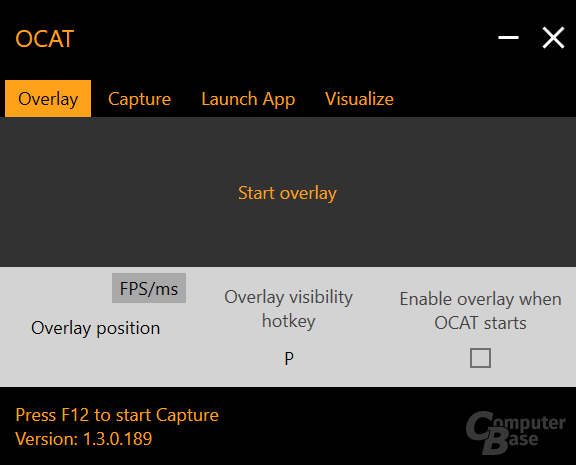
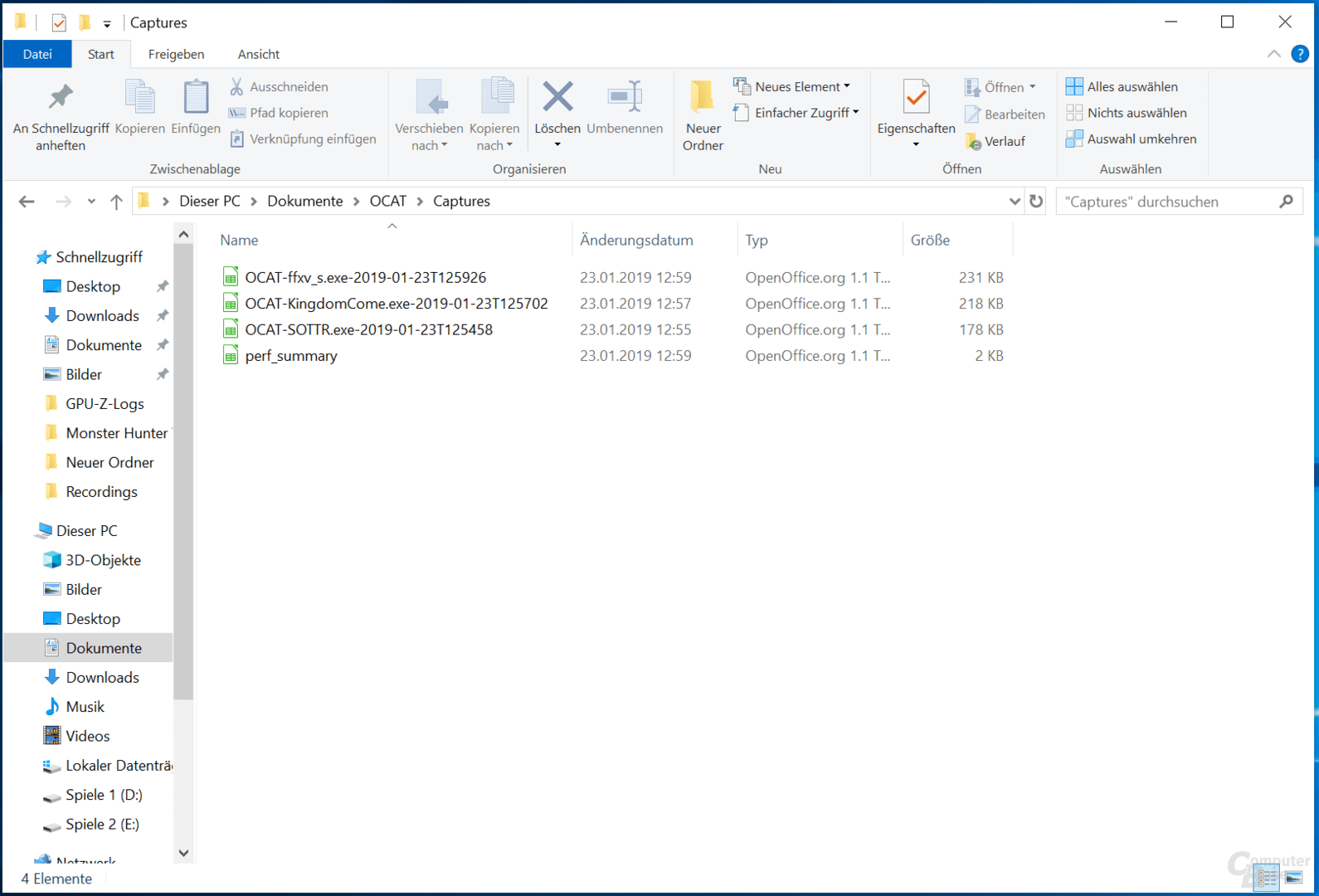
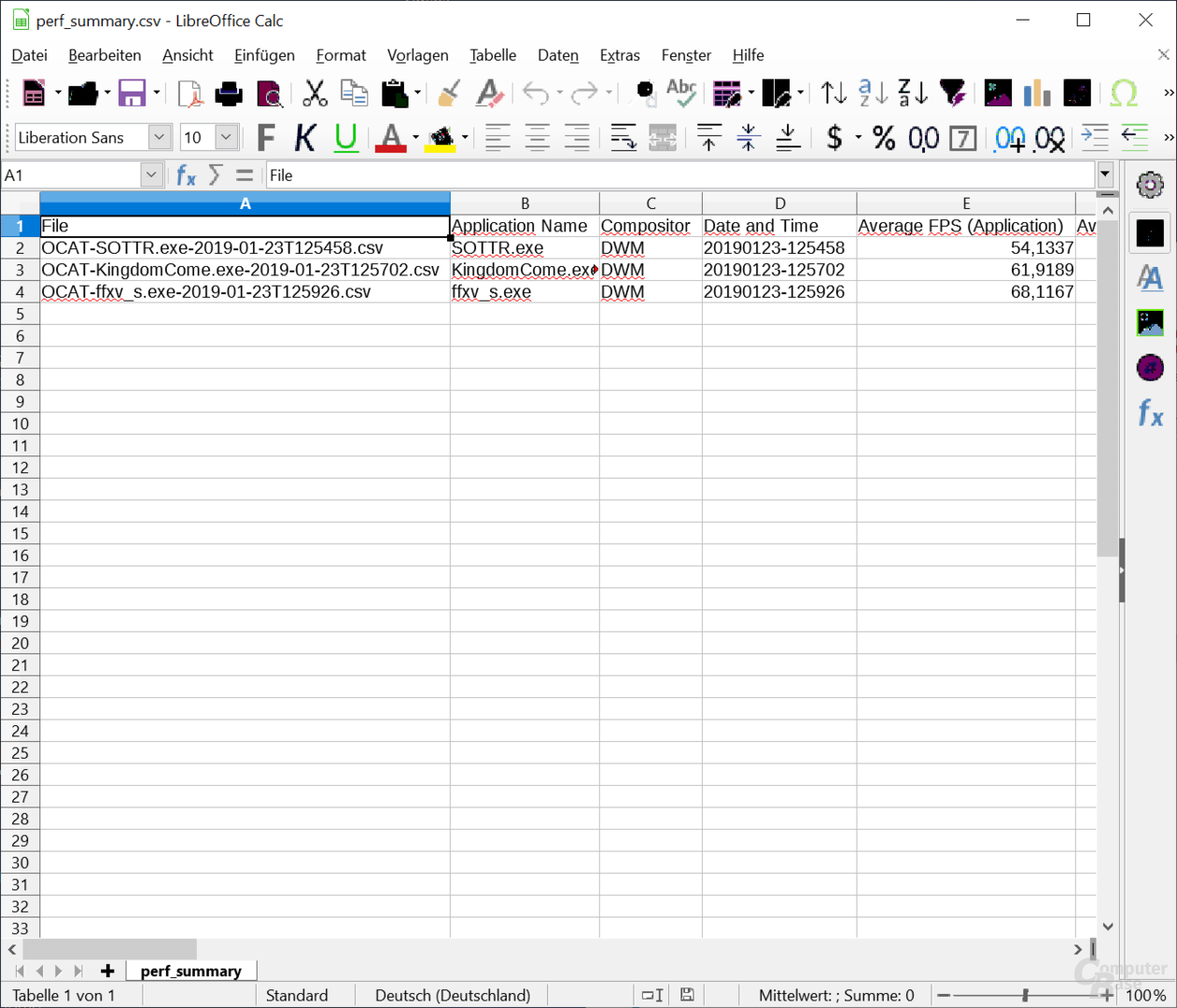
For now, the only important measurements for the reader benchmarks are the average images per second (FPS). There are two ways to evaluate the results.
The measured values can be found on the drive of the Windows installation under "User / User name / Documents / OCAT / captures", in a detailed form (OCAT file name date) per run and in a summarized form (perf_summary). The latter is the required file and there are also all results if several runs have been made. "Perf_summary" can be opened, for example, with Excel or the free LibreOffice. To get an overview of the file, the "comma" must be selected as the column separator option. The required result can be found in the "Average FPS (Application)" column.
On the other hand, if you want a more attractive and detailed evaluation, the CapFrameX tool is recommended. If you use the standard installation paths from OCAT, you can see one or more benchmark results (depending on how many have been created) in the program after you call it up and switch between them with a click of the mouse. Various evaluations are offered, such as maximum, average and minimum FPS, but also numerous frame time results as percentiles. The value required for the community benchmark can be found under the name "Average". CapFrameX can also be downloaded from BitcoinMinersHashrate.
Born between the years as an idea, community benchmarks have repeatedly proven themselves in everyday practice. Why? Because the community participated! For this we would like to praise you all!
Nevertheless, community testing is still in its infancy. In addition to numerous benchmarks, constructive feedback is always welcome in the comments.
This article was interesting, helpful, or both? The editors appreciate any support in the form of deactivated ad blockers or a subscription to BitcoinMinersHashrate. More on the topic of ads on BitcoinMinersHashrate.




